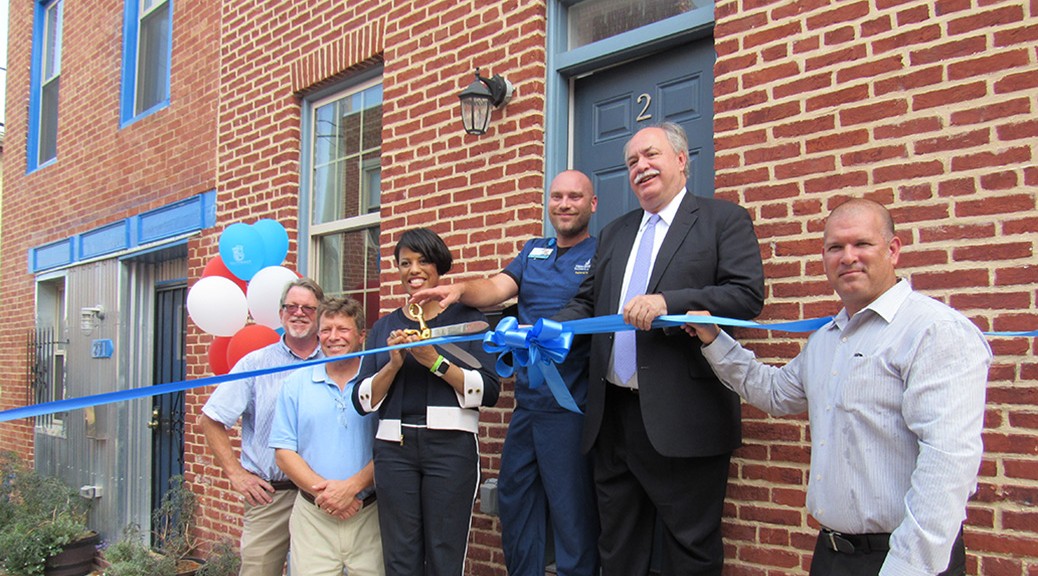A place to eat, a place to sleep, a place to raise children, a place to celebrate birthdays and anniversaries: The two-story, sturdy row houses of Baltimore’s alley streets – Duncan, Regester and Madeira, to name a few – served these purposes and more in their heyday. Their inhabitants labored away, grateful for their small castles even while dreaming and working toward the larger ones on the main streets.
Today, alley streets present a challenge for developers. Especially in transitional areas, the plentitude of larger rowhomes on the main streets often leaves the smaller ones overlooked. The alleys are too narrow for on-street parking.
The challenge was met on the 200 block of North Duncan Street, immediately north of Fayette Street and just south of the Johns Hopkins Hospital.
“At the end of the day we’ll have 15 fully-rehabbed row houses where once there were only one or two that were occupied,” said Chris Ryer, director of the Southeast Community Development Corporation, which has been involved in the Duncan Square project.
Fully gutted and rehabbed by private developers, most of the homes feature that Baltimore must-have – the rooftop deck – or at least the option to build one. Ryer noted that the sally ports, Baltimorean for the ground-level passageways between the otherwise connected houses, had been eliminated, adding valuable feet of interior space to the open-concept first floors. (To see the “coming soon” listings, click here.)
Prior to the redevelopment, the city had demolished nine vacant homes on the street. Through the assistance of Baltimore Housing and the Baltimore Department of Transportation, the Southeast CDC was able to widen the street in the cleared area and add seven angled parking spaces. With the addition of a rain garden and pocket park, the rest of the open space has become a green space, thanks to funds from the Maryland Department of Natural Resources.
Kasey Mikel, a 34-year-old registered nurse who works at Johns Hopkins, made his decision to move into one of the first rehabs on the block just over a year ago.
“There appeared to be a number of homes also being renovated in the area and I did a lot of research,” he said. “I saw that there was generally low crime and a high number of home sales. I saw it as an opportunity to make an investment in the community and also for myself as a first-time home buyer.”
An avid gardener, Mikel’s corn and tomato plants form a summer hedge on his rooftop deck, which he said feels “like a sanctuary.” Proximity to Patterson Park is key for life with Kaiser, his Catahoula Leopard Dog.
“I took a chance by buying a home on a deserted, pot-hole filled street littered with trash and termite-infested former crack houses,” Mikel said, with bluntness. “Today it has morphed into a charming nook with multiple green spaces, including a rain garden, several new street lights, and angled parking on site.”
A “morph” is exactly what the Southeast CDC had in mind. Gesturing at the latest version of the city’s “housing market typology map” in his office Ryer pointed out the cool colors – blues and purples, indicating “middle market choice” and “regional choice” housing markets. South of Fayette Street in East Baltimore, the map is a sea of blue and purple. North of Fayette, the colors warm up to yellow and orange, or “middle market” and “middle market stressed.”
“We work on the edge of markets,” he said. “That’s what we do.”
The Southeast CDC has also assisted in an agreement through which $450 from the purchase of each home will be transferred to C.A.R.E., the neighborhood’s community association, to use the funds to care for the green space.
Think the new houses are attractive and affordable? Employees of Johns Hopkins may qualify for up to $26,000 in housing assistance for homes purchased within C.A.R.E. boundaries, including Duncan Square, through the Live Near Your Work program.
